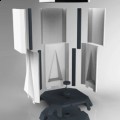I have no wish to dispute the decision of the judges in the annual innovative technology competition for the James Dyson Award.
The Canadian National Winner this year is a unique and much needed device; sadly, the news from the Philippines these days shows just how on-going the need is for Drop Pod.

The Drop Pod (seen in this ‘exploded view’) assembles with no tools, perfect for a hard-hit disaster area, and it can help stop water-borne disease while giving support to an overloaded emergency infrastructure.
Drop Pod is a new idea for removing human waste in natural disasters; the device is easily packed and shipped, and efficient to maintain. It stacks onto a standard military-size skid, assembles intuitively with no tools, and has ergonomic assistance built-in for the injured and infirm.
More importantly, it can stop water-borne disease and human contamination, while giving support to an overloaded disaster infrastructure.
Its inventor, Humber College graduate Adam Laufer, surely deserves to be named the 2013 James Dyson Award National Winner for Canada and to receive a $3,000 award for his work.
“In a natural disaster, or in a war zone, infrastructure disappears – so something as simple as human waste can get deadly really fast,” he explains. “This is a simple toilet that contains and sequesters feces and contaminated water. It requires no infrastructure, and doesn’t need any tools to put it together – which means it can be put up quickly and easily, before things get dangerous.”
Laufer was among several competitors for the Canadian prize, and also for an international grand prize.
The Canadian competitors included another student at Humber College, whose invention really caught my eye, or twisted my arm if you will.
ENE, as it is called, presents a way to charge portable electronics and mobile devices using energy generated and collected from body motion: think about swinging your arm around a few times, and re-charging your iPad!
Think about not having to find, connect and pay for an electrical outlet and requisite hydro – not just for yourself, but for the billions of gadget-users around the world.
By strapping on this high-tech arm — or leg — band, the device, developed by Joe Kiez, gathers kinetic energy from the wearer’s body motions, and charges a cellphone, tablet or MP3 players at what’s described as a 20-times-faster-than-normal rate!
I’d raise my hand anytime to get and use such a power source, and I hope that every other device user feels the same!
That’s an easy choice, because I sure would not want to need the Drop Pod.

Humber College graduate Adam Laufer has been named the 2013 James Dyson Award National Winner for Canada
Good for Adam Laufer, though, and good luck on further product developments.
He says he’s currently in the physical prototype phase and he’s hoping the product development cycle can stay in Canada, even as UNICEF and the UN show understandable interest in his innovative technology and design.
Other Canadian Dyson Award competitors:
- FLASK – Flood Assistance Streamlined Kit– A supply kit integrated with an inflatable raft that addresses life necessities during a post-disaster situation.
- HerSwab – A more comfortable method and convenient method for women to self-collect high quality vaginal samples for HPV.
- Lateral Moving Wheelchair – A low-cost wheelchair adaptation that allows users to move their wheelchair left and right using an arm crank.
- Genesis Adaptive Stroller – A wheelchair adaptable stroller that gives more freedom to parents to enjoy activities with infants and toddlers.
- Lublu – Infant Hospital Bassinet– A new style of bassinet that allows for isolated interaction, protecting infants from infection.
- Seismic Ring Fuse – A Low-cost retrofit to older buildings to mitigate damage from earthquakes.
- Robotic Surgery: Automated Suturing Tool– A robotic suturing invention that limits infection and free times.
- Atmos Flexible Private Enclosure– A modular, lightweight structure to increase privacy in crowded office environments.
The James Dyson Award is an international student design award run in 18 countries. The contest is open to university or college level students (or recent graduates) in the fields of product design, industrial design and engineering, who “design something that solves a problem.”
The Award has an international prize fund of $157,000, with $46,000 going to the winner and $15,000 to their university. This year, the International Winner is from the U.S, and the device, called Titan Arm, is an upper-body exoskeleton that supports and augments human strength, developed for use in occupational lifting and healthcare.
The James Dyson Award is run by the James Dyson Foundation, a registered charity supporting design, technology and engineering education, medical research charities and local community projects.
-30-
submitted by Lee Rickwood



